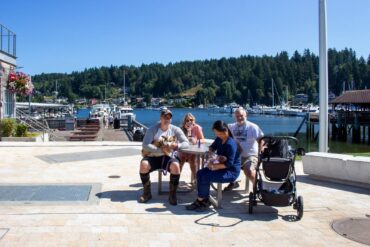
Seagulls screech overhead, kayakers and paddleboarders weave in and out of the marinas and visitors by the dozens stroll along the waterfront, stopping here and there to read an interpretive sign or snap a photo of the scenic view. Gig Harbor has long been a destination spot for visitors and locals alike. The city of Gig Harbor and several collaborating organizations are working to ensure a pleasurable and meaningful experience for those who wish to learn about the history and the culture of this excellent little bay.
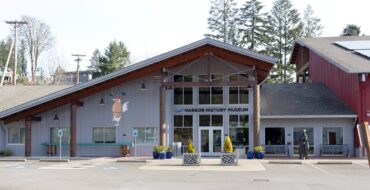
There are five public restrooms, six parks and several walkable piers along the 1.5-mile stretch between the Old Ferry Landing at the far east end of Harborview Drive and the intersection of Harborview and Peacock Hill at the north end. These “people places” provide creature comforts and resting spaces. Six of these spots even have picnic tables for those who carry their own snacks or enjoy takeout from one of the many restaurants along the way.
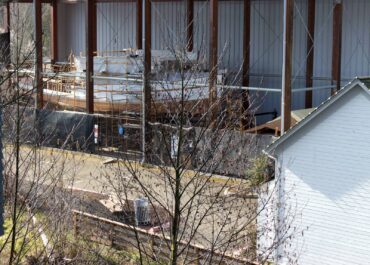
Two different styles of interpretive signs — one sepia-toned and the other multicolored — are interspersed along the entire length of Harborview Drive, providing information about the cultural as well as the natural history of the area.
The city installed the sepia-color signs in collaboration with the Harbor History Museum. Peninsula Historical Society furnished many of the photos reproduced on the signs. These cultural signs tell of the history of the early settlers, ferries, ship building, and the timber and fishing industries.
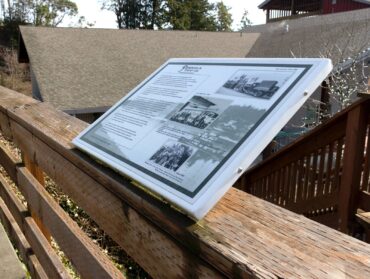
Harbor WildWatch designed and installed the brightly colored metal signs in cooperation with the city. These signs explain the flora and fauna of the area, as well as interesting facts about the waters of Puget Sound.
Ample street parking allows convenient access to historic sites and businesses within a relatively short walk along the entire stretch. Wide sidewalks and well-spaced benches invite walkers to sit and rest, socialize and just enjoy the view.
Picnic tables are located at The Old Ferry Landing, Skansie Park, on the waterside of the brick house at Eddon Boatyard, Austin Estuary, and the Ruth M. Bogue viewing platform across the street from Finholm View Climb. Trash receptacles can be found every several hundred feet, encouraging walkers to properly dispose of their refuse. Additionally, dog-poop bag kiosks are conveniently installed for those pet walkers who have left theirs at home.
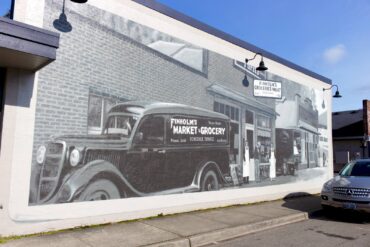
Honoring History
Capt. Charles Wilkes is reputed by some accounts to have brought his little boat or “gig” into the shelter of the harbor in 1847 to escape the ravages of a winter storm. He named the little bay “Gig Harbor” on his map of the Oregon Territory in 1841.
Shortly thereafter, in about 1847, three fishermen of European descent, Samuel Jerisich, Peter Goldsmith and John Farrague, rowed to the harbor from Vancouver and established a small fishing village. When these fishermen arrived, the only other people living near the harbor were about 50 members of the Twa-Wal-Kut branch of the Puyallup Tribe.
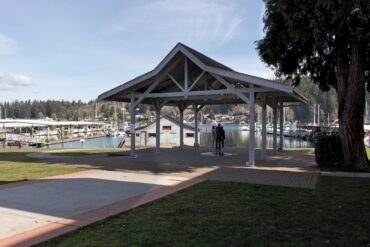
The ancient Native settlement consisted of a long house and several huts located at the head of the harbor near the present location of Donkey Creek Park. Today, the city is in the process of renaming the Austin Estuary Park to honor the first people of the Gig Harbor area.
The North End
Beginning at the north end of the Harbor in the Finholm District, you will discover the Finholm View Climb, across the street from Anthony’s restaurant, near Peacock Hill. A 100-step climb to the top rewards visitors with the iconic “postcard” view of the harbor, its many marinas and — on a clear day — Mount Rainier.
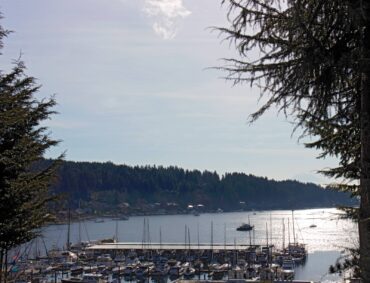
The local Lions Club built the view climb with contributions from members of the community. Construction began in 1996 and the structure was commemorated in 1999, at which time it was deeded over to the city of Gig Harbor.
City crews maintain and update the Finholm View Climb as needed, while members of the Lions meet quarterly to tidy up the landscaping. There are benches strategically placed for resting and viewing all the way up, and a restroom kiosk is located at the bottom in the parking lot. Note: The parking lot itself is designated for Anthony’s customers.
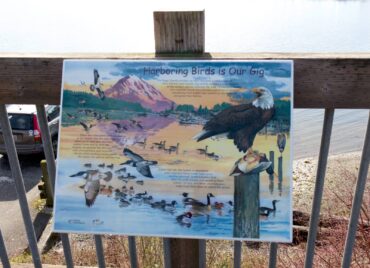
Walking west from the bottom of the Finholm View Climb, notice the mural painted by Lita Dawn on the Finholm market wall, depicting a scene from the early 1900s. Across the street is the Ruth M. Bogue viewing platform, marked with Connie’s Clock that was installed by the Rotary of Gig Harbor. Artist Stuart Nakamura created the metal sculpture, titled “Memory Vessel,” that graces the platform.
Learn about the birds of the area on one interpretive sign, and two residents of the area who were lost to Mount Everest on the other. Continuing along the sidewalk, follow it to the left, where the bridge affords a good view of Donkey Creek flowing into the harbor, and the back side of the Harbor History Museum.
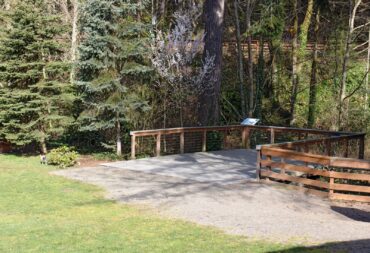
Donkey Creek Park and History Museum
Before taking the stairway down to the museum, cross over to Donkey Creek Park on your right and take the path down to the observation area overlooking the creek. The interpretive sign here explains the life cycle of salmon, which you can observe spawning in good numbers from this area in the late fall months.
Donkey Creek is named after a “donkey engine” brought to the area in the early 1900s at the time of the construction of the Austin Mill, when cedar logging was in full swing.
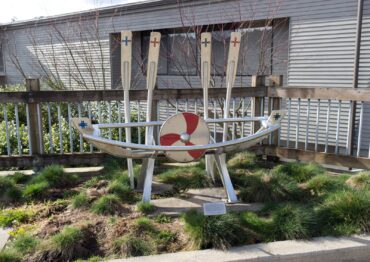
Guided walks and interpretive talks sponsored by the environmental education organization Harbor WildWatch in collaboration with the Downtown Waterfront Alliance and Harbor History Museum originate at Donkey Creek Park or at the Harbor History Museum across the street. Note: Guided walks will resume when state guidelines indicate it is safe to do so.
Before crossing the street to the museum, have a look at the beautiful bronze sculpture “Ringing in the Salmon” by Tom Torrens and sculptor Ben Isitt. After crossing the street from Donkey Creek Park, take the stairway down to the Harbor History Museum. You will find this museum to be relevant to the history of the area, as well as family-friendly and interactive.
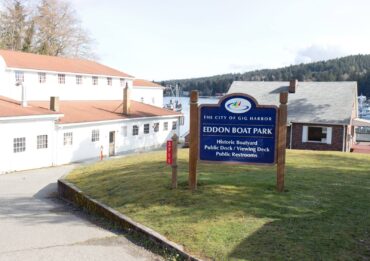
The focus of the museum is on the South Sound Native Americans, early settlers, transportation, logging, fishing, agriculture and the evolving growth of the peninsula. Of course, there is also an exhibit about the infamous “Galloping Gertie Bridge.”
Active restoration of the 65-foot purse seiner “Shenandoah” provides a new experience with each return visit. The one-room Midway School house, which dates to 1893, was moved to the museum and authentically renovated in 2009. Be sure to give yourself time to explore the museum before continuing on your walk along the waterfront.
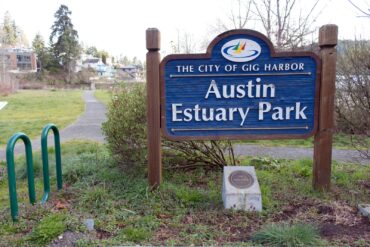 The Austin Estuary
The Austin Estuary
Exiting the museum building, take note of the life-sized bronze statue “Big Catch” by Douglas Brannum. Then turn left toward the water to Austin Estuary, which has been dedicated to the early Puyallup peoples. The land here is being remediated with native plants and grasses, and it’s being reclaimed by the water as part of the estuary.
As the community began to grow, a great deal of lumber was required for homebuilding and ship building. The Austin saw mill, the first built on the banks of the harbor, was established here about 1909 and provided employment for many men and boys in the community. The Austin Estuary is a good spot for birdwatching, and there is a picnic table at the water’s edge.
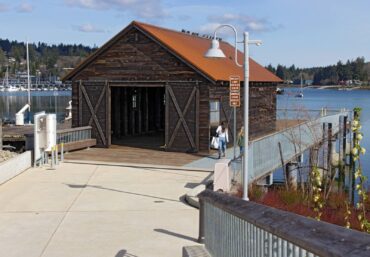
Gig Harbor Boat Shop
Return to the sidewalk, turn left and walk about 1/3 mile to the Gig Harbor Boat Shop. Conrad Anderson established the first boat building here in 1924 and, with access to a deep-water launch, many large fishing boats were built on this site over the years.
Art Glein bought the business in 1945 and built the present structure and the brick house next door. In 1950, Glein sold to Ed Hoppen and Don Harder, who named it Eddon Boatyard, and the name stuck until recently renamed.
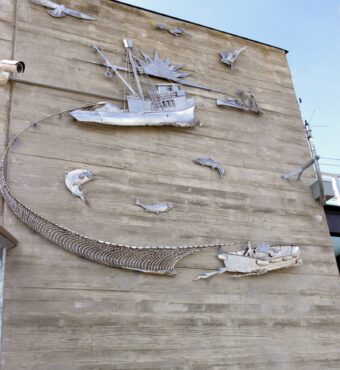
Be sure to go inside and have a look around, and go down the hill to the boat shop itself. There’s always some sort of boat building activity going on there. In the summer, you can rent historic boats for a spin around the harbor.
The Millville District
Leaving the boat shop, in a block or two, you will enter the Millville District, where historic homes dot both sides of the street. The Ancich Waterfront Park, with viewing platform and picnic tables, is at street level. Notice the wall with metal sculptures by Olalla artist Gary Jackson.
Walk down the ramp or steps to find restrooms and beach access, or onto the pier to the left and discover the Ancich Netshed. As early as 1910, Gig Harbor’s first netsheds began appearing along the waterfront. According to the city’s website, “many families passed the netsheds and fishing vessels down for several generations. Of the remaining 17 netsheds along the shore (as of 2015), seven are still used by local fishermen to store and repair their nets and gear. The Ancich netshed and its simple form, materials and scale represents a typical netshed in Gig Harbor and is one of a cluster of five historic sheds along this section of working waterfront.”
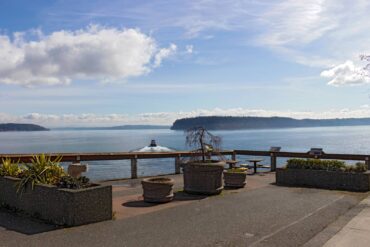
A brochure, titled “All Along the Waterfront,” is available at many of the city visitor information kiosks found at the restrooms. It explains the location and has photos of the historic netsheds still standing today.
Downtown Center
The center of downtown Gig Harbor is located at Skansie Brothers Park and Jerisich Dock. During the summer months, concerts and movies take place here, the farmers market runs from June through September, and a massive lighted Christmas tree is erected in early December.
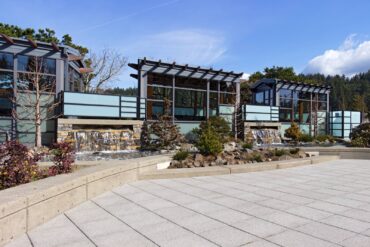
Andrew Skansie built the brick home on the premises in 1908. The building now serves as the City of Gig Harbor Visitors Center and houses the offices of Harbor WildWatch. The historic Skansie Netshed, which is normally open to the public, is owned by the city and offers displays of tools and nets used in the fishing industry. Knowledgeable volunteers are on duty to answer questions.
The restroom facility at this park offers a large viewing platform up on the roof, as well as public restrooms and keyed showers for boaters who have paid an overnight fee to moor on Jerisich Dock. The fountain offers a splash play area for children at the base of the Alexandre Safonov bronze sculpture, which honors local fishermen lost at sea. Inside the pavilion, don’t miss the bas-relief medallion by local artist Mardie Rees.
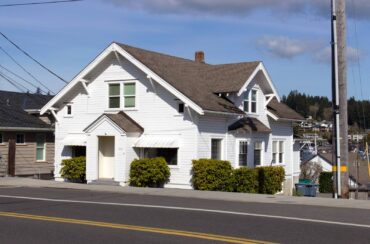 The South End
The South End
Continuing just past Pioneer Street, the large building on the left is one of the first LEED (Leadership in Energy and Environmental Design) buildings in Washington. Read the information sign out front and take a stroll through the garden while enjoying the large water feature. Threshold Group, a philanthropic foundation, owns the building.
Exiting the garden by the steps, a left turn will take you to the Maritime Pier. Once known as the People’s Pier, it’s the site of Gig Harbor’s second ferry dock and also a commemoration of the vibrant local fishing industry that exists today.
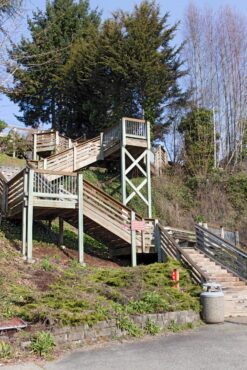
The dock is built to facilitate the loading and unloading of nets and cargo for those who don’t have their own docks in the harbor. The Gig Harbor commercial fishing fleet consists of upwards of 120 permit holders, and collectively they fish for crab, herring, sardines, squid, salmon and tuna, in a range from Northern California to Alaska.
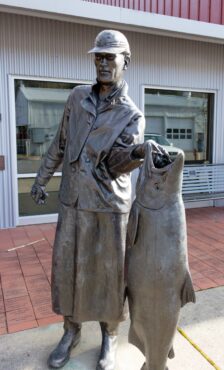
The Maritime Pier shares a parking lot with the iconic Tides Tavern, a restaurant and bar with outside dining. The building dates to 1908, built by Axel Uddenberg as a general mercantile. (See WestSound Home & Garden March/April 2018.)
About 1/4 mile beyond the Tides, Harborview comes to an end at the Old Ferry Landing. A parking lot here only has space for three or four vehicles. It has a picnic table and a few interpretive signs.
This ferry brought passengers and goods to Gig Harbor from 1928 until 1940, when the first Tacoma Narrows Bridge was built. The natural history sign at this spot explains the scope and breadth of Puget Sound, home to hundreds of species of marine mammals and invertebrates.
Whether you have an hour or a day to explore the history, the wonder or the secrets of historic Gig Harbor — the Maritime City — you won’t be disappointed in what you experience.




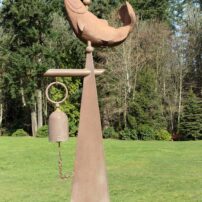
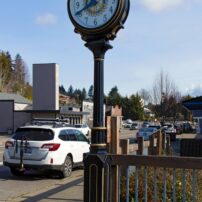
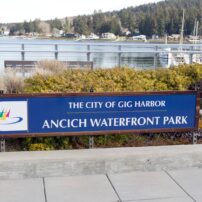
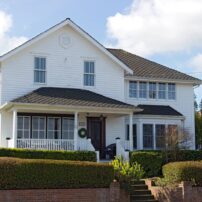
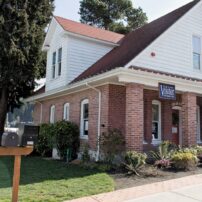
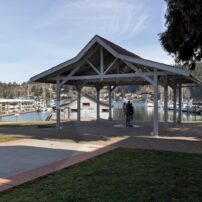
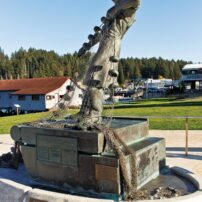
























Comments